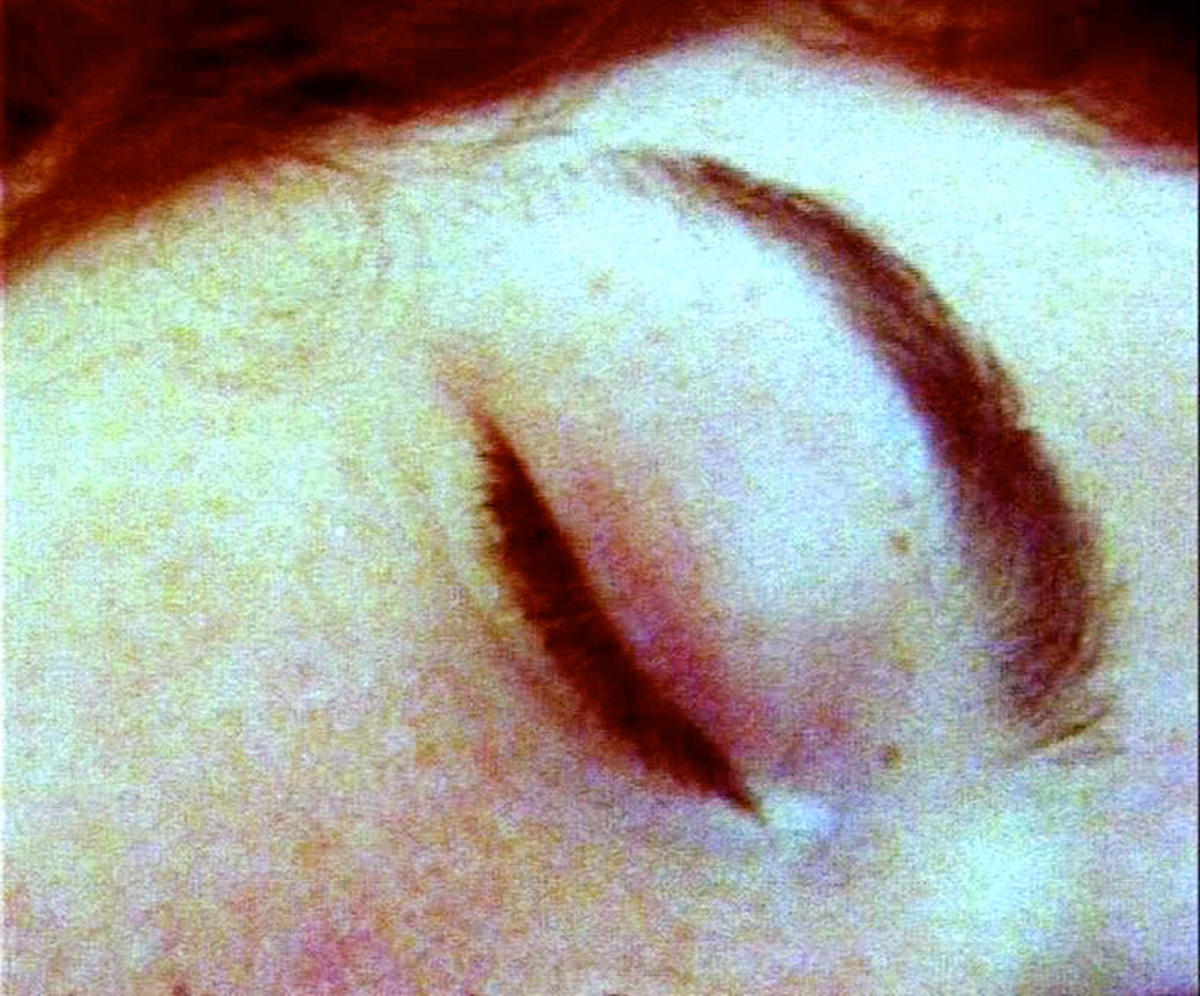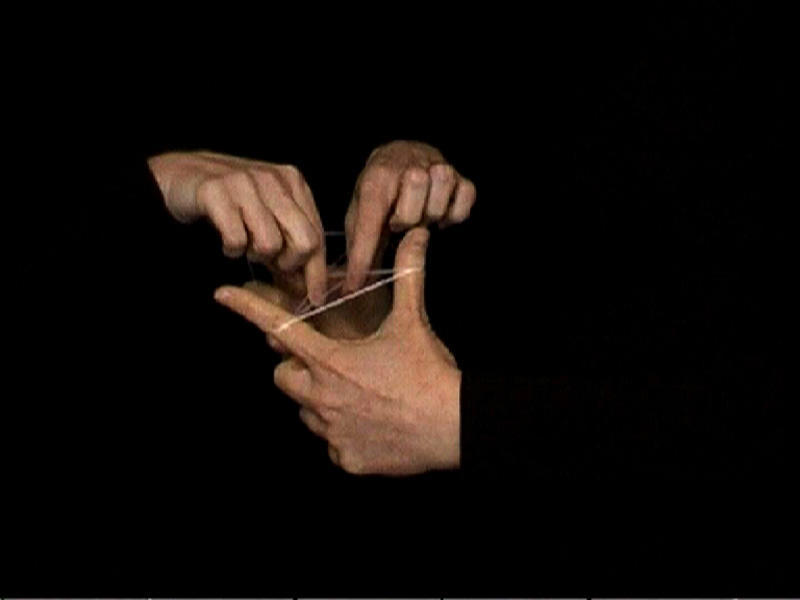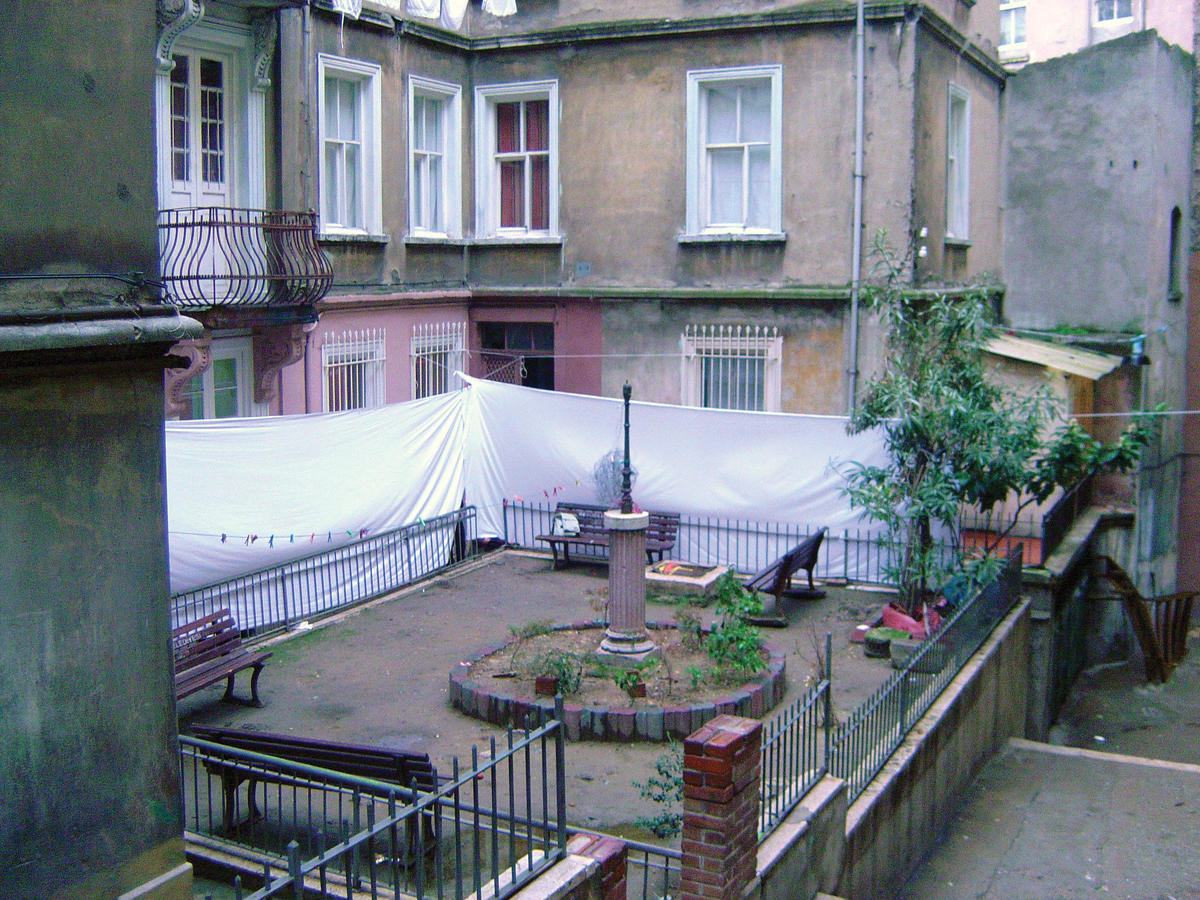
Beirut
Lamia Joreige
Galerie Janine Rubeiz
May 12–June 10, 2004
Lamie Joreige has a keen eye for surfaces — for skins, silk screens, and skims of paint, for images reflected on glass and abstractions washed over canvases. Born in Beirut, raised in Paris, and educated in the States, she is now back in Lebanon, living and working and showing a dexterous hand at navigating two vastly different media — painting and video. Among Beirut’s small but vital pack of intellectually rigorous and critically engaged contemporary artists, Joreige is one of the very few to be both a staple of film festivals and be represented by a proper gallery. Over the past nine years, she has navigated with ease the alternative and traditional channels of artistic production in Lebanon that otherwise stand in stark opposition to one another.
While Joreige’s films often carry suggestions of painterly-ness, she has for the most part kept her canvases separate from her video works. But the segregation has vexed her. So, for her latest solo exhibition at the blue-chip Galerie Janine Rubeiz, Joreige has pulled off a beautifully accomplished forced integration of sorts.
“Time and the Other,” on view from May 12 through June 10, plays out in three parts, like chapters in a loose novel. Part one, called Embrace, features six images — all stills shot with a Super-8 camera and then transferred to video, massively enlarged, and printed on paper — along with a four-and-a-half minute video. Part two, entitled Sleep, consists of three huge single images and four long strips of another 31 images in series, like diary entries, and accompanied by another video. The final part, Lost Chords, includes seven lush paintings for which Joreige has taken photographs of the body, tweaked them in Photoshop, transposed them onto archival paper, and painted the surface.
The story unfolding in this exhibition is one of love and loss, and also one of violence and sex. Yet Joreige manipulates the tensions in her surface so well that all such content lurks enigmatically rather than announcing itself stridently. One medium bleeds into another, presence into absence. Appearances are never quite what they seem, stretching a thin yet intriguing veneer over realities always threatening to rupture Joreige’s surfaces from beneath.
Jerusalem
Al-Ma’mal Foundation for Contemporary Art
The Jerusalem Network
A nonprofit organization aims to promote, instigate, disseminate, and make art. We serve as an advocate for contemporary art and a catalyst for the realization of art projects. We aspire to create opportunities for experimentation, inspiration, and education. We give special emphasis to working with children and youth. We invite artists to come to Jerusalem to work and present their work. The forum we provide is a conduit through which we strive to contribute towards the evolution of the cultural fabric of society, which gives art more possibilities to become a mode of expression and a way of life.
The Jerusalem network is an ongoing effort to connect and collaborate with institutions and individuals at the local, regional and international levels. Al-ma’mal organizes workshops and exhibitions in partnership with community centers, youth clubs, and educational institutions and in collaboration with local and foreign artists, engaging children and youth in activities that stimulate their senses and introduce them to a wide range of materials and media. Through al-ma’mal’s workshops, children and youth are provided with opportunities to be engaged in art and express themselves through the different media painting, drawing, photography, video, sculpture etc.
This July, Ayrene Anastas will be visiting Jerusalem to work on her proposed art project and will be hosted at the foundation as part of the artist-in-residence program. August will host an exhibition by Zeyad Dajani Dajani was hosted at the foundation for the residency program last year. The exhibition is a selection of the work the artist created while in the residency. In September 2004, Jananne Al-Ani will be returning to Jerusalem as an artist in resident to continue with the development of her work.

Amman
Makan
Bidoun speaks with Ola Khalidi, the founder of a new art space in Amman called Makan.
Bidoun: How would you describe “Makan” and your work? It is a gallery? An alternative gallery?
Ola Khalidi: Makan is an alternative cultural house/space founded for the purpose of showcasing contemporary art in its various forms, by providing a space for expression and interaction amongst young emerging artists in Jordan. The goal is to allow for the networking and exchange of ideas in the hope that they would result in art projects and performances in and outside Makan. It is hoped that Makan would eventually also become a regional hub for art and artists.
B: Do you see Makan as part of the development of new art spaces in the Middle East?
OK: Well I would consider it as a development because it’s established in Amman, and it’s the first of its kind …it concentrates on the emerging artists mainly, the idea is to develop the young artists, whether by hosting their projects, connection them with other institutions, informing them about workshops or festivals, introducing them to other artists, or trying to involve them in joint projects. That’s why I don’t like to call Makan a “gallery.”
B: Do you think that a network already exists between the “new” art galleries?
OK: I have already established links with similar alternative spaces that work with contemporary art but of course older, i.e. Zico House in Beirut, Townhouse gallery in Cairo, Al – Mamal Foundation in Jerusalem …
I think most of the spaces try to link with each other, because they are not that many and we all need each in some way or another.
So answering your question, yes there is some sort of a network between the new art spaces.
B: When did you start Makan?
OK: Makan started officially in April 2003.
B: Why did you first become involved in this project, and how did it develop?
OK: My involvement began with young artists whether they were friends or people that I worked with and how much I felt their thirst for an alternative space where they can express their ideas and thoughts without any restrictions or boundaries .It stemmed from the need for a space that would understand their needs and frustrations and connect them with each other.
So far the results have exceeded my expectations. I started off alone, and now after one year I was able to establish some sort of a network of young talented people who are involved in Makan. In addition we were able to establish connections with many other organizations and individuals in the field of art and culture and we are in the process of developing projects together.
B: What is your professional background?
OK: I hold a B.A in political Science and Public Administration from the American University of Beirut and a Masters degree in Management from the University of Surrey in England.
OK: I worked for two years in a cultural café called Blue Fig in Amman. After that I moved to Beirut and worked with an NGO called Beirut D C (Beirut Development and Cinema) and then I started doing research on my project (Makan) and it took around 8 months before I started it.
B: What are your future plans?
OK: Near future: involvement in art projects that have to do with development and mainly children. Mainly our future plans are to reach more to the public, and widen our audience. But I try as much as I can to work on a small scale and grow bit by bit. I would have to add that this is a self-funded project, that’s why at this stage our projects are all very low budget; we work with the minimum.

Istanbul
Oda Projesi
Oda Projesi is an artist collective based in Istanbul, Turkey. The core group consists of Özge Açıkkol, Günes Savas and Seçil Yersel. Oda Projesi which means Room Project, is about thinking of the different usages of the “room”: finding a way to combine the daily life and art practices. The dynamics of space is a big part of the project.
The project was intiated in 2000 in an apartment located in a neighbourhood called Galata. At first we rented an apartment as a shared studio in 1997 in the same neighbourhood. During that time, the studio became a meeting place for children, for women living in the neighbourhood and for artists, so the idea of the Oda Projesi originated from the art practices in Istanbul and from the energic dynamics of the neighbourhood. The project takes the concept of the room (oda) as the basic space to start with and extends its area of interest to the courtyard, the street, the neighbourhood and finally the city itself. We want to bridge relations between artists, non-artists, artist-run groups, institutions and the communities in the neighbourhood. Our objective is to give a new meaning to the artist’s identity by using the collective structure of the public space, to destroy the art subject and the object’s pedestal, to develop relationships and to represent the whole process as a work of art.
Galata, where Oda Projesi is based, is a neighborhood very close to the entertainment and cultural center of the city, Beyoglu, where all kinds of events take place and where people from different social and economic backgrounds come together. Beyoglu has always been historically important because of its multinational structure; it’s there that the first Westernization movement took place. As the center for foreigners, it also has a vital role in the traffic of commerce. At the end of Istiklal avenue is Galata which was the old harbor neighborhood and which used to be the old Jewish neighborhood. When the owners moved out, the old buildings became home to the first generation of immigrants who came to Istanbul from the east and north of Turkey in the late ’70s and mid-’80s. The area has been undergoing a gentrification process for the past 10 years and is continuously changing and being shaped by the circulation of people such as journalists, artists and so on. Since the gentrification is where Oda Projesi finds itself, we thought that we could develop a relationship within the neighborhood of Galata and transform the gentrification process.
Ever since our first project — when Özge Açıkkol emptied the room and exhibited it with the text of George Perec, About a Useless Space — we have been extending invitations for our neighbors in Galata to meet in an unidentified place and talk about various possibilities that could take place there.
These on-site events often do not have any object-like end-product, similar to what happens in performance art, in the sense that what we call the artwork is temporary in character — meaning that it is performed at some place within a certain amount of time and does not leave behind anything for display. The only thing left behind in this kind of event would be an experience. One such event was called Picnic. The artist Erik Göngrich was invited to participate in an Oda Projesi project. He organized a picnic in the courtyard, in which the neighbors and the artists participated. Based on the idea of “Istanbul as picnic-city,” the courtyard was arranged, people brought food, and a whole afternoon was spent eating, playing and chatting. And then the event concluded with the slide show by the artist.
La Biennale des Cinémas Arabes
L’Institut du Monde Arabe, Paris and Marseille, France
June 26–July 4, Paris
June 28–July 3, Marseille
The premiere outing for Arab cinema in Europe — if not the world — the seventh Biennial promises its usual roundup of the best features and documentaries produced over the past two years competing for prizes totalling 31,500 Euros. This year’s festival also includes un hommage to Egyptian grande dame Madiha Yousry, and a retrospective devoted to Iraqi cinema. While the professionals debate subjects such as “the role of television in documentary production” and “the nature of Iraqi cinema,” adventurous moviegoers can catch around 100 films at various cinemas in Paris, including the IMA. There’s also a slightly smaller version of the festival in Marseille.
Berkeley
Sacred Space
Berkeley Arts Center
June 20–August 7, 2004
Seyed Alavi, Taraneh Hemami, Dee Hibbert-Jones, Rhoda London and Rene Yung explore the meditative potential of art in this exhibition curated by Terri Cohn. “In light of the uneasy social, cultural, and economic climate that has emerged and continues to unfold since 9/11,” say the organisers, “‘Sacred Space’ invites its audience to a space of reflection created by site-specific installations that use a poetic visual language to express issues that are both personal and political.”
San Francisco
Ala Ebtekar: Elemental
Intersection for the Arts
June 16–July 31, 2004
Painter Ala Ebtekar explores the merging of styles from two different cultural traditions spanning opposite ends of the world and separated by centuries: Iranian coffee house culture and American hip-hop culture.
South Korea
Pierre Bourdieu In Algeria: Testimonies of Uprooting
Institut Français de Séoul, South Korea
June 11–July 18, 2004
The tour of Bourdieu’s images from his field research work in Algeria, 1958–1961, organised by Camera Austria, continues to South Korea. The first presentation of the French sociologist’s photographs, the exhibition “testifies to a social world full of non-simultaneities, whose people even today have not overcome their uprootedness.” It is scheduled to travel on to Germany and Sweden.
Paris
Musulmans au Caire, à Téhéran, Istanbul, Paris, Dakar
Parc La Villette, Pavillon Paul Delouvrier, Paris
Until November 14
Described as a “series of portraits and stories rooted in five large, modern cities,” this exhibition aims to explore the “new ways of living and being Muslim” that emerge in the dynamism and tensions traversing today’s metropolises. The exhibition includes reportage from Cairo’s Nabil Boutros and Istanbul’s Manuel Çitak and Patrick Zachmann, new work by Tehranis Khosrow Hassanzadeh and Sadegh Tirafkan, and a Senegalese mural by Papisto Boy.
Barcelona
Documentary Fictions
CaixaForum
Until June 27
Inspired by (and including) Kutlug Ataman’s Women Who Wear Wigs, Caixa Forum explores the links between art and documentary cinema with screenings of twenty-two films and videos by twenty-one international artists, including Sobhi Al-Zobaidi, Keren Amiran, Kutlug Ataman, Harun Farocki, Avi Mograbi, Walid Raad, Tacita Dean, Allan Sekula, and Zineb Sedira.